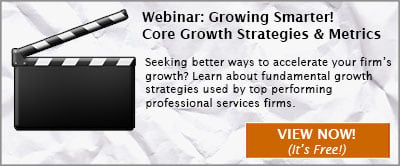Measuring Marketing ROI: Building a Better Relationship with Accounting
When it comes to proving the value of marketing efforts, often professional services marketers have to prove their worth to the financial department through a language that they understand – Marketing Metrics! This often means a series of pre-determined metrics for measuring marketing ROI (return on investment).
 Marketers are often challenged with measuring marketing ROI. Many times it’s because we are don’t have access to the right type of data or in some cases it’s because we don’t know what to measure. This is where having a good relationship with finance can help you be a better marketer. To better develop the relationship and expectations between marketing and finance, we suggest fostering a relationship of understanding and sharing.
Marketers are often challenged with measuring marketing ROI. Many times it’s because we are don’t have access to the right type of data or in some cases it’s because we don’t know what to measure. This is where having a good relationship with finance can help you be a better marketer. To better develop the relationship and expectations between marketing and finance, we suggest fostering a relationship of understanding and sharing.
Having the financial department on your side is one of the greatest feats any marketer can accomplish – If finance buys in, you can be assured that it is only a matter of time until everyone else falls in place!
No matter how copasetic our relationship is with our financial department, we have to be ready to report on marketing ROI at a moment’s notice so here are some steps to take to gain a better relationship.
Talking the Talk
If you are looking at building a better relationship with accounting, in my experience the first bridge to cross is to put yourself in their shoes. When you think about what functions accounting is responsible for, you can easily understand their hesitancy to buy in to the marketing plan without cold hard data to evaluate. Instead of running from this hurdle, attack it straight on! Schedule a kick-off meeting with finance to address the plan, and allow them to voice any concerns.
The goal during the kick-off session is to ease accounting’s anxiety. Allow the finance department a chance to express their suggestions and concerns. Continue to reassure the finance team that through the marketing metrics established by your firm, you will be consistently measuring marketing ROI throughout the year to ensure that the marketing team’s plans and efforts stay on track.
Walking the Walk
The quickest way to gain buy in is to lead by example. You know your job better than finance knows your job. Identify areas that your marketing efforts affect that might not be easily identified. One way a Marketer can begin to do this on their own is to think about the data that you need to do their job better. Come to the kick off meeting ready to show your finance team that you understand their concerns, by identifying previously overlooked metrics for measuring marketing ROI. This will demonstrate to finance that you are looking at metrics that can help impact the growth of the company and further prove your value to the firm.
If you are interested in learning more, review this blog article that discusses evaluating your business growth plan with metrics. This introduction can be applied to developing marketing metrics that help identify how your efforts are helping the firm grow.
Here are important questions marketers can ask accounting to start the conversation on how the firm can start measuring marketing ROI:
- Retaining & Gaining Clients: I’m looking to understand our total customer growth. Do we have a way to determine by percentage and revenue the amount of our work we’ve received is new vs. existing clients throughout the year?
- Pursuing the Right Client: I’m been looking at how we can be more strategic in our pursuit of clients. Would it be beneficial to advise you when I see we are pursuing more work with clients that we are having AR issues with?
- Forecasting and Backlog: Can you help me understand what our break-even is and do we have a way to see what our current backlog is? I’d like to help make sure we have enough business coming in the pipeline for each market or division.
- Effectiveness: Can you help me better understand how I affect the bottom line? Developing metrics that help you understand the financials behind your results can help you fine tune your approach.
Often times your finance team is not questioning the value of the marketing team -- they are however questioning the tactics (and results!) being used. Often times as marketers we can get lost down in the weeds and lose sight of the overall firm goals. By proving efforts through metrics and marketing ROI, we start speaking a language that our financial team can understand.
As professional services marketers, start showing your finance team that you care by measuring marketing ROI, and building better relationships between marketing and finance to demonstrate the value of promotional efforts.
For more information, view the below webinar:



 1. Understand how and where you’ve succeeded.
1. Understand how and where you’ve succeeded.
 For most professional services firms, planning for growth is a natural part of business. There are different strategies for doing so, and choosing the best one depends on your ultimate growth objectives. But whatever your goals, understanding how your growth plan affects your cash flow plan is essential to achieving the results you seek.
For most professional services firms, planning for growth is a natural part of business. There are different strategies for doing so, and choosing the best one depends on your ultimate growth objectives. But whatever your goals, understanding how your growth plan affects your cash flow plan is essential to achieving the results you seek.

 What is forecasting? Forecasting is a tool that many professional services firms use to help management make decisions based on past and current data trends.
What is forecasting? Forecasting is a tool that many professional services firms use to help management make decisions based on past and current data trends. 

 Achieving consistent project profitability while maintaining strong client relationships is at the top of most firms’ goals and objectives. And, while there are certainly a number of variables that must be integrated to make this happen, asking your clients for feedback during the project plays a valuable role. I’ve identified two scenarios that are common in the A/E industry. Incorporating feedback into your project management process has been demonstrated to have a positive impact on both.
Achieving consistent project profitability while maintaining strong client relationships is at the top of most firms’ goals and objectives. And, while there are certainly a number of variables that must be integrated to make this happen, asking your clients for feedback during the project plays a valuable role. I’ve identified two scenarios that are common in the A/E industry. Incorporating feedback into your project management process has been demonstrated to have a positive impact on both.
 Budgeting and forecasting is part art, part science. For too many firms, however, it is also a frustrating process that takes a lot of effort to produce less than optimal results.
Budgeting and forecasting is part art, part science. For too many firms, however, it is also a frustrating process that takes a lot of effort to produce less than optimal results.
 You might be tempted to think that the hardest part of using business performance metrics to guide your business is gathering and analyzing the metrics.
You might be tempted to think that the hardest part of using business performance metrics to guide your business is gathering and analyzing the metrics. 
 Each of your clients, like you, are individuals that have a unique definition for what a positive client service experience means to them. We can no longer treat everyone the same way – it just doesn’t work! Sending client surveys gives your firm the opportunity to ask clients what that terrific experience looks like to them – each of them. It also gives you the chance to show that your firm is serious about their satisfaction and to build stronger relationships. As a result of the thousands of survey results and comments we’ve seen, we wanted to share with you the top 3 reasons clients want you to send them a client survey.
Each of your clients, like you, are individuals that have a unique definition for what a positive client service experience means to them. We can no longer treat everyone the same way – it just doesn’t work! Sending client surveys gives your firm the opportunity to ask clients what that terrific experience looks like to them – each of them. It also gives you the chance to show that your firm is serious about their satisfaction and to build stronger relationships. As a result of the thousands of survey results and comments we’ve seen, we wanted to share with you the top 3 reasons clients want you to send them a client survey. You may find it helpful to know that there is no ”right” way to go about evaluating your business growth plan (or knowing that might actually make you even more anxious!). There are however, several reliable tips for getting the most out of the effort.
You may find it helpful to know that there is no ”right” way to go about evaluating your business growth plan (or knowing that might actually make you even more anxious!). There are however, several reliable tips for getting the most out of the effort. 